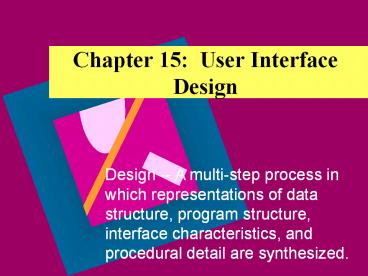Chapter 15: User Interface Design - PowerPoint PPT Presentation
Title:
Chapter 15: User Interface Design
Description:
Disclose the information in a progressive fashion. 6. 3. Make the Interface consistent ... Determine functions & procedures using/producing the data. External ... – PowerPoint PPT presentation
Number of Views:20
Avg rating:3.0/5.0
Title: Chapter 15: User Interface Design
1
Chapter 15 User Interface Design
Design -- A multi-step process in which
representations of data structure, program
structure, interface characteristics, and
procedural detail are synthesized.
2
Interface Design
- Three Areas of Concern
- Interfaces between software modules
- Interfaces between software and non-human
producers and consumers - For example, sensors and actuators
- Interfaces between the human and computer
3
The Golden Rules
- Place the user in control.
- Reduce the users memory load.
- Make the Interface consistent.
- This golden rules actually form the basis for a
set of user interface design principles that
guide software design activity.
4
1. Place the user in control.
- Define interaction modes that does not force a
user into unnecessary actions. - Provide for flexible interaction
- Allow user interaction to be interruptible and
undoable - Streamline interaction as skill levels advance
- Hide technical internals from the casual user
- Design for direct interaction with objects that
appear on screen
5
2. Reduce the users memory load
- Reduce demand on short term memory
- Establish meaningful defaults
- Define shortcuts that are intuitive
- Visual layout of interface should be realistic
- Disclose the information in a progressive fashion
6
3. Make the Interface consistent
- Allow the user to put the current task into a
meaningful context - Maintain consistency across a family of
applications - If past interactive models have created user
expectations, do not make changes unless there is
a compelling reason to do so.
7
INTERNAL EXTERNAL INTERFACE DESIGN
- Intermodular interface design
- DFDs show data flow between modules
- Arrows map into parameters in and out of
interface - Determine functions procedures using/producing
the data - External interface design
- Typically involves both hardware software
- Often supplied by vendor
- Often complex functionality
- Data validation and error handling
8
USER INTERFACE DESIGN MODELS
- Design Model - data, architectural, interface,
and procedural representations - User Model - profile of end user, categorization
as novice, intermittent, or frequent user
expert - System Perception - users model end users
mental image of the system - System Image - outward appearance and supporting
information
9
USER INTERFACE DESIGN PROCESS
- User, task and environment analysis modeling
- Interface design
- Interface construction
- Interface validation
10
The user interface design process
11
TASK ANALYSIS MODELING
- Define and classify tasks
- Stepwise elaboration
- Establish goals and intentions for task
- Map goal to sequence of actions as it will be
executed through the interface - Specify action sequence
- Indicate state of the system
- Define control mechanism and effects on system
state - Indicate how user interprets system state
12
DESIGN ISSUES
- System response time - primary user complaint
- Length
- Variability
- User help facilities - integrated vs. add-on
- Scope
- Access methods
- Representation
- How return to normal process
- Structure
13
DESIGN ISSUES (cont)
- Error information handling - reduce user
frustration - Understandable language
- Constructive advice
- Negative consequences of error
- Audible or visible cue
- Nonjudgmental (dont call user an idiot)
- Command labeling - hot keys vs. point and click
- Scope
- Form
- Ease of use
- Customization or abbreviation
14
IMPLEMENTATION TOOLS
- UIDS User Interface Development System
- Managing input devices
- Validating user input
- Handling errors and displaying error messages
- Providing feedback
- Providing help and prompts
15
IMPLEMENTATION TOOLS (cont)
- Handling windows and fields
- Establishing connections between application
software and Interface - Insulating the application from interface
management functions - Allowing the user to customize the interface
16
DESIGN EVALUATION
- Length and complexity of written specification
- Number of commands, average number of arguments
per command, operations per action - Number of actions, commands, and system states --
memory load on user - Interface style, help facilities, and error
handling protocol
17
Interface Design Evaluation Cycle
18
End of Chapter































